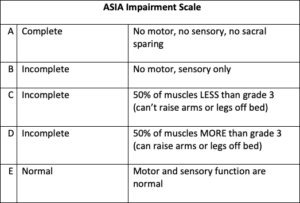 The ASIA Impairment is simply a system of standards that doctors use to classify spinal cord injuries. It’s easy to understand, once you know how it works. The scale was developed by
The ASIA Impairment is simply a system of standards that doctors use to classify spinal cord injuries. It’s easy to understand, once you know how it works. The scale was developed by
the American Spinal Injury Association as a universal classification system for SCI, and is used throughout the world.
Here’s how to read the ASIA Impairment Scale:
There is an individual scoring system that is applied to each case that starts by asking: Is the injury complete or incomplete?
Complete: There is no feeling or movement below the place where the spinal cord was damaged, so no messages can travel to or from the brain to the area below the injury. On the ASIA Impairment Scale, this is rated an ASIA A-Complete.
Incomplete: There is some feeling and movement below the location of the spinal cord injury; this means some messages are able to travel to and from the brain to the area below the injury.
There are four classifications of incomplete injuries. On the ASIA Impairment Scale, these are rated:
ASIA-B –Incomplete; means there is incomplete sensory (some feeling), but no motor function (ability to move) is preserved below the level of injury.
ASIA-C—Incomplete; means there is motor function which is receiving some messages (muscle contractions) below the level of injury, but more than half of the key muscles* below the level have a muscle grade of less than 3 (so they are unable to lift against gravity
ASIA-D—Incomplete; means there is motor function (movement) below the level of injury, and at least half the key muscles* below the injury level have a muscle grade of 3 or more (able to move and lift against gravity)
Or —
ASIA-E (Normal); Motor (movement) and sensory function(feeling) are normal (back to where they were before the injury).
|
* Key muscles in the body are: |
Here is a list of the top 4 video Q&A’s from our video library about spinal cord levels of injury.
1. What is meant by a “complete” spinal cord injury?
Dr. David Chen of the Shirley Ryan Ability Lab in Chicago answers:

2.What is meant by an “incomplete” spinal cord injury?
Dr. David Chen of the Shirley Ryan Ability Lab in Chicago answers:

3. How do you answer the question “Will I ever walk again?” after a spinal cord injury?
Dr. Leslie of the Shepherd Center in Atlanta answers:

4. How did you develop an understanding of your injury?
Clinton, with Paraplegia since 2005 answers:

To learn more about the ASIA Impairment Scale see this section of the FacingDisability.com website.
To see a chart of the actual ASIA Impairment Scale doctors use to make these classifications click here for a printable PDF. It was last revised in 2019.
Leave a Reply